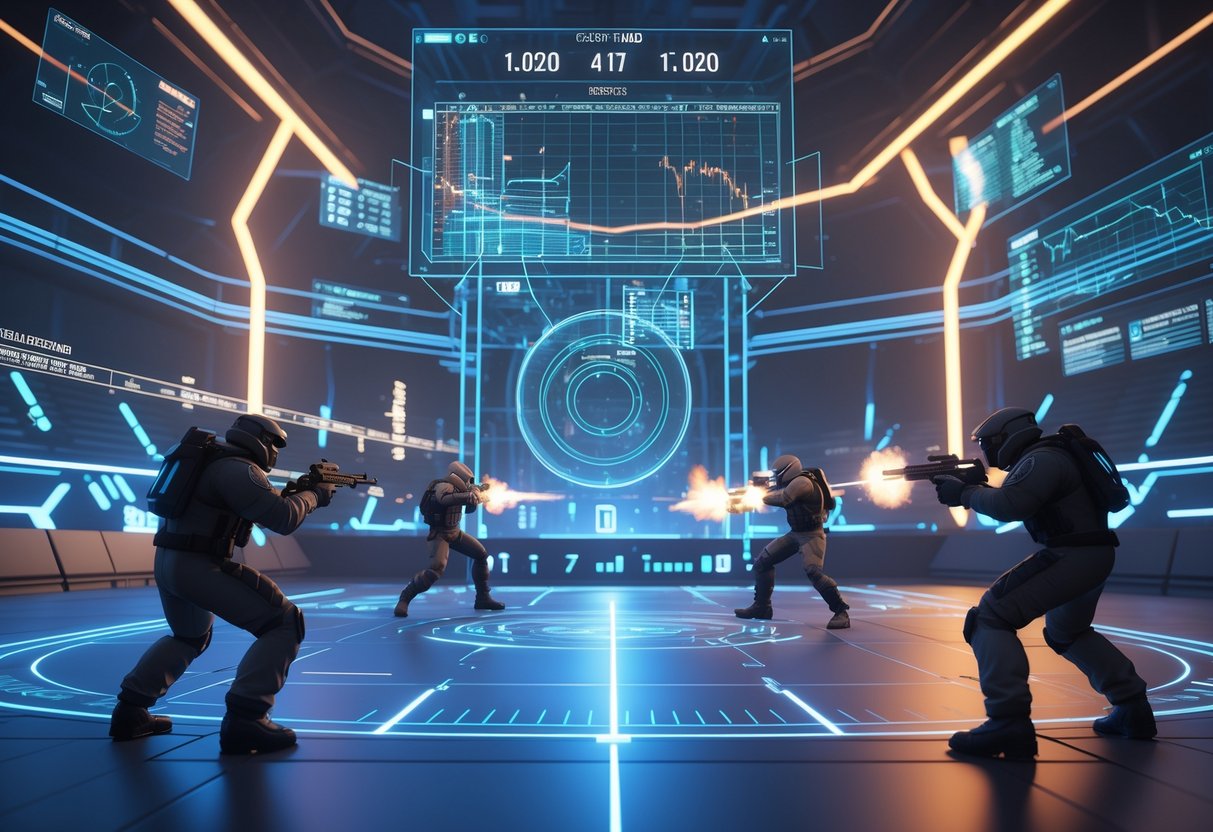CS2 Subtick System Explained: How It Works and Impacts Gameplay
Updated On: November 13, 2025 by Aaron Connolly
CS2 Subtick System: Core Concepts
The subtick system in CS2 is a pretty major change from the old tick-based approach. Valve built this new tech to finally get rid of those annoying timing inconsistencies that always seemed to haunt Counter-Strike.
They wanted a game that just feels snappier and more accurate.
What Is the Subtick System in CS2?
Instead of waiting for the next tick, CS2 now records your actions right when you do them. So, when you click to shoot or toss a grenade, the server grabs that input instantly.
Old tick-based systems only checked for actions at set intervals. In CS2, if the server runs at 64 ticks per second, it used to only notice what you did 64 times each second.
Subtick blows past that limit.
Here’s a quick look at how subtick handles different actions:
| Action Type | Traditional System | Subtick System |
|---|---|---|
| Weapon firing | Processed at next tick | Processed instantly |
| Movement | Updated every tick | Captured precisely |
| Utility throwing | Delayed to tick boundary | Immediate registration |
Each input now gets timestamped down to the microsecond. When you pull the trigger, CS2 doesn’t just record that you shot—it remembers exactly when during the tick you did it.
This makes the game feel smoother. What you see on your screen finally lines up with what the server knows.
No more second-guessing if your shot should’ve landed or not.
How Subtick Differs From Traditional Tick Systems
Traditional tick systems tick along at fixed intervals, like a clock. CS2’s 64Hz servers update 64 times per second, which leaves tiny gaps where your actions just wait.
Subtick fills in those gaps. Instead of lumping all actions together every 15.6 milliseconds, the system processes each input as it happens, using that precise timing.
Some big differences stand out:
- Timing accuracy: Old systems round your actions to the nearest tick. Subtick keeps the exact moment.
- Input lag: Ticks add artificial delays. Subtick cuts those out.
- Fairness: Players with different pings get more consistent action registration.
So, if two players shoot at nearly the same time, the server checks who actually acted first, not just who happened to land on a tick boundary.
That split-second edge really matters.
Why Valve Introduced the Subtick Update
Valve brought in subtick to fix problems that drove competitive players nuts for years. Issues like inconsistent hit registration and endless arguments about tick rates just wouldn’t go away.
Subtick kind of makes tick rate a non-issue. Instead of shelling out for 128Hz servers (which isn’t cheap), Valve made smarter use of the existing 64Hz setup.
James Connolly, a gaming expert, said, “Subtick represents the biggest technical advancement in Counter-Strike since the move to Source engine. It finally addresses the core timing issues that have plagued competitive play.”
This change really helps in a few ways:
- Competitive integrity: Now, your skill and timing matter more than server quirks.
- Cost efficiency: Valve keeps 64Hz servers but still boosts performance.
- Player experience: Fewer missed shots, less frustration.
Players with high ping probably notice the difference most. Their actions get a fairer shake compared to the old tick system.
Tick Rate Versus Subtick in CS2
Tick rate tells you how often the server updates, but subtick tracks your actions between those updates. Together, they make CS2 a lot more precise than older games.
What Tick Rate Means in Online Shooters
Tick rate is just how many times per second the server updates. It’s like the server’s heartbeat.
In CS2, servers tick along at 64 Hz. That means 64 updates every second.
Each tick, the server handles everything you do—shooting, moving, nades, all of it.
Higher tick rates mean more updates:
- 64 Hz = 64 updates per second
- 128 Hz = 128 updates per second
Platforms like FACEIT run 128 Hz servers, which feel smoother since they check for your actions more often.
On a 64 Hz server, there’s about 15.6 milliseconds between updates. If you shoot, your input might wait up to that long before it gets processed.
Tick Rate Limitations in Previous Counter-Strike Versions
CS’s old tick system had real timing issues. Your actions only counted at the next tick, not when you actually did them.
Problems popped up like:
- Shots fired between ticks felt off
- Movement didn’t always feel snappy
- Timing got inconsistent
If you shot at 15.5 milliseconds on a 64 Hz server, you had to wait for that last 0.1 milliseconds. That tiny pause could decide a round.
Players always wanted 128 Hz servers to cut down on this delay, but even those couldn’t fix the core problem.
High ping made things worse. If your connection lagged, you waited even longer, and low-ping players got the advantage.
The Relationship Between Tick Rate and Subtick
CS2’s subtick system works with the 64 Hz tick rate, not instead of it. Tick rate still sets the rhythm for server updates, while subtick handles the timing of each action.
Here’s a simple breakdown:
| Component | Function | Timing |
|---|---|---|
| Tick Rate | Updates game state | Every 15.6ms (64 Hz) |
| Subtick | Records actions | Instantly when performed |
When you shoot, subtick notes the exact instant you clicked. The server then works that timing into the next tick update.
So, CS2 keeps the familiar 64 Hz stability but adds the sharpness of instant action recording.
This makes the game feel more consistent, even for players who used to struggle with delay.
The subtick system especially helps if you have higher ping. Your actions still get registered at the right time, even if your connection isn’t perfect.
How the Subtick System Works Under the Hood
Subtick processes your inputs right as you make them, not just at the next server tick. It grabs the exact timestamp for every action and syncs your gameplay with everyone else.
Processing Player Actions Between Ticks
With old tick systems, your actions only mattered at certain intervals. If you shot between ticks, the server just waited for the next one.
Subtick changes all of that. When you click, the system instantly captures the exact moment you did it.
Here’s what happens step by step:
- Your client saves the exact timestamp
- The action gets tagged with that timing
- It sends this info to the game server right away
- The server processes it based on when it really happened
So, your shot gets counted at the exact millisecond you pulled the trigger. Same for movement—every jump, crouch, or sidestep is timestamped right away.
If you do a lot at once—shoot, move, throw a nade—each action gets its own timestamp.
Server Calculations and Input Timestamps
The game server takes your timestamped actions and crunches the numbers. It figures out where you were, what you were aiming at, all of it.
Here’s how the server handles your input:
| Step | Process | Result |
|---|---|---|
| 1 | Receives timestamped input | Knows exact action timing |
| 2 | Calculates player position | Determines precise location |
| 3 | Processes game physics | Applies realistic movement |
| 4 | Validates against other players | Prevents cheating |
Ping still matters for how fast your actions reach the server. Subtick adjusts for this by looking back to when the server got your input.
If you’re playing with 50ms ping, the server checks what was going on 50ms ago. That way, your actions get counted at the right moment, not just when they finally show up.
The server checks these calculations constantly. It makes sure your position and speed make sense, so you can’t cheat the system.
Synchronisation for Precise Movement and Shooting
Everyone needs to see the same thing at the same time. Subtick keeps everyone in sync using those precise timestamps.
If two players shoot at the same moment, the server figures out who actually fired first—even down to fractions of a millisecond.
Movement works a bit differently. Your position gets updated smoothly, not in choppy steps, so other players see you move cleanly instead of jumping around.
It even handles tricky situations, like peeking corners. When you peek, your opponents see you exactly when you start moving, not a split second later.
Ping differences get evened out by the timestamp math. If you have 100ms ping and your opponent has 20ms, the server still processes your actions based on when you actually did them.
Ping, Input Lag, and Online Responsiveness
Subtick changes how your inputs reach the server by recording the exact time for every action. This leads to smoother gameplay even if your ping isn’t perfect, though your connection still matters.
How Subtick Reduces Input Delay
Old tick systems made your actions wait for the next update. If you fired halfway between ticks, your shot just sat there until the server noticed.
Subtick grabs your click the instant you press it. Your mouse input gets timestamped and sent to the server with that precise timing.
The big wins:
- Actions register between ticks instead of waiting
- Less of that “laggy” feeling
- The game matches up with when you actually did things
So, your shots feel more responsive. The server processes them based on the real timing, not just the next tick.
You might still notice some delay in the visuals, though. The system is way better than before, but sometimes what you see lags behind what actually happened.
The Influence of Ping on Subtick Accuracy
High ping still affects subtick, just not as badly as before. Your timestamped actions have to travel to the server and back.
With 50ms ping, your input takes 50ms to get there. Subtick processes it at the right time, but you still feel the network delay.
Ping effects with subtick:
- Low ping (under 30ms): Barely any impact
- Medium ping (30-80ms): Minor delays, still responsive
- High ping (over 100ms): You’ll feel the delay
Lag compensation helps a lot. The server can tell you fired at “tick 1.1” instead of “tick 2,” so your shots land more often than they would’ve before.
Connection quality matters, too. A steady 60ms ping often feels better than a jittery 30ms ping.
Comparing Online Performance: Subtick Versus Legacy Systems
CS’s 64-tick servers updated 64 times per second. This schedule left 15.6ms gaps between updates, so actions during those windows often felt off or laggy.
| System | Update Method | Action Timing | Input Feel |
|---|---|---|---|
| CS 64-tick | Fixed intervals | Rounded to nearest tick | Often delayed |
| CS 128-tick | Fixed intervals | Better precision | Improved but limited |
| CS2 Subtick | Continuous timestamps | Exact timing recorded | More responsive |
With the subtick system, separate 128-tick servers aren’t necessary anymore. Now, the game captures the exact moment you act, no matter what the server’s tick rate is.
Real performance differences:
- Weapon firing feels snappier
- Movement inputs land more accurately
- Grenade throws reflect the instant you release
Some players say it takes a little time to get used to. The system just handles actions differently, and if you’ve played on ticks for years, it can feel weird at first.
Network stability matters even more now. Clean connections let you really feel the subtick benefits, but packet loss can still mess with timing.
Impact on Competitive Gameplay and Meta

The subtick system has changed how Counter-Strike 2 plays at the top level. Pro players talk about different movement timing and shooting precision, and teams have shifted their strategies to match new spray patterns and utility mechanics.
Pro Player Experiences With Subtick
Pros have mixed feelings about CS2’s subtick update. A lot of them say movement techniques just don’t feel the same as on classic 128-tick servers.
ropz, one of CS2’s top riflers, said in interviews that counter-strafing timing needs some relearning. The subtick system processes movement inputs in a new way, so muscle memory from years of play doesn’t always work.
Counter-strafing is sometimes more forgiving now. You can land accurate shots with a bit less perfect timing. But this has also thrown off players who mastered the old rhythm on 128-tick.
Movement techniques affected:
- Jiggle peeking timing
- Counter-strafe accuracy windows
- Air acceleration patterns
- Crouch peeking responsiveness
Several pro teams have put in extra practice hours to adjust their mechanics. The transition feels especially tough for players who relied on tight movement timing.
Some pros say the subtick system feels more responsive, especially for quick flicks and fast reaction shots. Others, though, struggle with complex movement sequences that just don’t flow like before.
Spraying and Recoil Control Changes
Recoil compensation has shifted a lot with subtick. The system tracks your inputs more precisely, so spray patterns feel different during long bursts.
Key spray pattern changes:
- First bullet accuracy still holds up
- Mid-spray corrections feel sharper
- Spray transfers between targets don’t behave quite the same
- Burst firing timing is just… different
Pro players say AK-47 and M4 spray control needs some tweaks. Subtick tracks your mouse between old tick intervals, so recoil compensation can feel smoother.
CS2’s recoil system listens to tiny mouse movements now. You can make finer corrections, but that also means you can over-correct more easily.
Competitive implications:
- Teams spend extra time on aim training
- Spray practice routines need updating
- Individual dueling styles keep evolving
- Long-range spraying doesn’t work quite the same
A lot of pros have nudged their crosshair placement to match the new precision. With subtick, small mistakes stand out more during matches.
Utility Usage and Movement Adjustments
Grenade lineups and utility timing needed major changes in competitive play. Subtick’s timing affects smoke throws, flash timing, and even explosive damage.
Smoke grenade changes:
- Deployment timing is steadier
- One-way smoke tricks work differently
- Lineup precision feels off from old setups
Teams have had to rebuild their utility routines. Classic CS smoke plays either needed tweaks or got tossed out.
Flash timing is more predictable with subtick. The system calculates flash effectiveness right to the moment, so pop-flash setups and team plays needed some reworking.
Movement in utility scenarios:
- Running through smokes feels different now
- Molotov damage ticks at new intervals
- Jump-throw binds are more reliable
- Boost timing needs a new rhythm
Pro teams say coordinated plays need more practice to sync up. Subtick processes everyone’s actions at once with more accuracy, so team timing matters more—and it’s more doable.
Tactical adaptations include:
- Reworked smoke execute timings
- Updated flash coordination calls
- Changed retake positions
- Adjusted rotation timings
Teams have blocked off time just to relearn utility basics. The changes are technical upgrades, but they’ve added a real learning curve for veteran squads.
Platform Differences: FACEIT, Official and Third-Party Servers

When CS2 dropped, different platforms took their own approach to server tech. FACEIT started with 128-tick servers, while Valve stuck to subtick everywhere.
Why FACEIT’s 128 Tick Servers Changed
FACEIT rolled out 128 tick servers with CS2 in September 2023. They figured higher tick rates would beat Valve’s new subtick system for gameplay.
FACEIT built its name on better servers. For ages, they ran 128 tick, while Valve matchmaking stayed at 64 tick.
Players noticed server quality differences. Some pros, like shox, said “FACEIT servers run faster, smoother” than the official ones.
But this setup caused inconsistency. Gameplay mechanics changed depending on the platform. Stuff that worked on FACEIT didn’t always land on Valve’s servers.
The community split. North American pros like fl0m and freakazoid said they felt “no differences whatsoever between servers.” European players often said the opposite.
FACEIT’s 128 tick move kept the debate alive about CS2’s subtick. Plenty of competitive players just preferred the old tick rates over Valve’s new tech.
Valve’s Standardisation and Community Reactions
Valve stepped in and enforced sub-tick on all servers. FACEIT and other third-party services had to drop their 128 tick setups.
Valve wanted everyone to get the same gameplay, no matter where they played—official or third-party.
Community reactions? All over the place. Some players liked the consistency. Others were annoyed about losing the 128 tick servers they trusted.
Competitive players still flocked to FACEIT, though. The platform’s anti-cheat and more serious environment kept it ahead of Valve’s matchmaking.
Community research showed CS2’s subtick system matched 128 tick in packet times. But player opinions didn’t always line up with the numbers.
Valve’s move showed real commitment to subtick. They wanted the whole competitive scene to play by the same rules, even if not everyone agreed.
Client-Server Synchronisation in CS2 Subtick

Subtick changes how your actions sync with the CS2 server. Instead of waiting for the next tick, the game records the exact instant you fire or move and matches it up with the server’s timeline.
Visual Representation Versus Server Registration
What you see on your screen doesn’t always match what the server processes. Old systems made this gap obvious—shots looked perfect but didn’t count.
CS2’s subtick system closes that gap. When you shoot, your client marks the exact moment you clicked. Subtick sends this timestamp to the server.
The server checks where enemies were at that moment. Now, visual feedback lines up much better with what actually gets registered.
Quick win: Your shots count when you actually fire, not when the next tick rolls around.
Players with higher ping get a more even experience. Before, network delays made actions feel sluggish or random.
How Client-Side Actions Are Matched to Server Data
Your game constantly sends action timestamps—movement, shots, grenades—to the server, all with precise timing.
The server lines up these actions in order and figures out the game state at each moment, not just on ticks.
If players’ actions clash, the server uses subtick timestamps to sort it out. This gives you better hit detection and movement registration.
Heads up: Your internet connection still matters. Bad ping will mess with sync, subtick or not.
The server then sends confirmation back to you. This back-and-forth keeps your screen matching the server’s reality within milliseconds, instead of waiting for the next tick.
Subtick System in Comparison With CS and Older Titles

CS used fixed tick rates—64Hz or 128Hz—processing actions at set moments. CS2’s subtick grabs your inputs right when they happen, so you don’t have to wait for server updates anymore.
Key Differences Between CS2 and CS Networking
CS’s Traditional Tick System CS handled player actions at fixed ticks. On 64-tick, the game updated 64 times a second. Bump it to 128-tick, and you got twice as many updates.
Your shot could register up to 15.6ms late on 64-tick. Pros complained about “hitreg” problems, especially in clutch moments.
CS2’s Subtick Revolution Subtick logs actions the instant they happen. When you shoot, CS2 records the exact time—no waiting for the next tick.
Your movement, grenade throws, and shots all land with pinpoint timing. No more “that should’ve hit” moments caused by the tick delay.
| System | Processing Method | Delay | Accuracy |
|---|---|---|---|
| CS 64-tick | Fixed intervals | Up to 15.6ms | Standard |
| CS 128-tick | Fixed intervals | Up to 7.8ms | Better |
| CS2 Subtick | Instant capture | Minimal | Precise |
What Transfers Over: Familiarity and New Challenges
Familiar Fundamentals Your core Counter-Strike skills still work in CS2. Spray patterns, map knowledge, and tactics all carry over. The game keeps its base 64Hz tick rate for general stuff.
Movement and weapon handling feel a lot like CS. Pros adapted fast because the basics didn’t change much.
New Learning Curve Subtick punishes sloppy aim more. You can’t blame missed shots on hitreg as easily.
Movement tricks like counter-strafing feel a bit off thanks to the new input timing. Players have needed time to retrain their muscle memory.
The system shrinks the edge 128-tick servers gave in CS. Now, official matchmaking and third-party services like FACEIT are on more equal footing.
Community and Professional Feedback on Subtick

The subtick system has split the CS2 community since launch. Pro players praise its responsiveness, but others complain about hit registration not always lining up.
Positive Receptions From Players
A lot of players like how subtick cuts input lag compared to old tick systems. Actions now register right when they happen, not after a server delay.
Pros notice the boost in responsiveness during fast rounds. Movement feels smoother and shots connect closer to when you click.
Players report these benefits:
- Less delay between clicking and shooting
- More accurate grenade throws
- Better sync between what you see and what the server gets
- A fairer experience for higher ping players
Subtick helps even out the playing field across different connections. Now, someone with 50ms ping can compete better against someone with 20ms.
Some Steam forum users share good experiences, saying there are fewer moments where shots look on target but somehow miss.
Criticisms and Reported Issues With Consistency
Even with its advantages, subtick gets flak for acting inconsistently in different situations. Some players say spray patterns just feel off compared to old-school Counter-Strike.
Common complaints include:
- Recoil control feels unpredictable
- Hit registration can get weird during peek fights
- Movement mechanics don’t feel quite right compared to earlier versions
- Official matchmaking and third-party platforms behave differently
Pro players can’t seem to agree on how subtick impacts competitive play. Some like the snappier feel, but others get anxious about whether it’ll stay consistent in tournaments.
Valve keeps tweaking subtick, using community feedback to guide regular updates. They’re still ironing out the kinks.
On Reddit and elsewhere, players talk about how the system sometimes lets them down at crucial moments. These hiccups can decide matches where split-second timing really matters.
Addressing Common Myths and Misunderstandings

A lot of people mistakenly think subtick totally replaces tick rates or that higher tick servers always win out over subtick tech. Actually, both systems work together and fill different roles.
Do Tick Rate and Subtick Replace Each Other?
Subtick doesn’t get rid of tick rates—it works with them. CS2 servers still use tick rates, but Valve’s subtick system tracks actions between those ticks.
Picture it like this: if a server runs at 64 tick, it updates 64 times every second. Subtick notes the exact moment you fire between those regular updates.
So, your shot might happen at tick 1.3, not just tick 1 or 2. The server stores that exact timing to decide if your bullet landed.
CS2 still has a base tick rate. Subtick just adds another layer of precision.
Heads up: Some folks expect subtick to magically turn 64-tick servers into 128-tick ones. It helps, but the base tick rate still matters for how responsive things feel.
Is Higher Tick Always Better Than Subtick?
Higher tick rates aren’t always better than subtick. Each solves different problems in online play.
A 128-tick server updates twice as often as a 64-tick. That means more frequent updates, but it eats up more resources.
Subtick cares more about timing accuracy than just update speed. It lets a 64-tick server record shots more precisely than some old 128-tick systems.
Still, subtick isn’t perfect. Some movement feels better on traditional high tick rate servers without subtick in the mix.
Quick tip: Try both if you can. Some players swear subtick helps with hits, but others stick with classic tick rates for smoother movement.
What works best? It depends on your playstyle and how good your connection is. No system nails it for everyone.
Monitoring, Adjusting, and Understanding Your Server Connection

You can keep tabs on your tick rate and how subtick is handling things using CS2’s built-in console commands. These tools help you see if your connection is doing what it should with the game’s server tech.
How Players Can Check Tick Rate and Subtick Performance
Checking tick rate is simple with CS2’s developer console. First, turn on the console in your game settings under “Game.”
While playing, hit the “~” key to open the console. Type cl_showfps 3 and press enter. You’ll see your tick rate in the top-left corner.
That number tells you how many times per second the server updates. Most CS2 servers run at 64 Hz—so, 64 updates every second.
You can also use net_graph 1 for more network info. It’ll show your ping, packet loss, and frame rate.
Subtick runs in the background with any tick rate. You can’t directly measure it, but smoother gameplay usually means it’s working.
If you feel input lag or notice delayed shots, your connection might not be keeping up. High ping makes subtick less helpful in cutting down delays.
Useful CS2 Console Commands for Network Information
Some console commands give you a closer look at your connection to CS2 servers. They’re handy for spotting network issues that mess with your games.
status tells you your current server’s tick rate, map, and who’s connected. That way, you know what kind of server you’re on.
ping gives you your connection delay in milliseconds. Lower is always better for subtick.
Try net_graph 2 for advanced stats like choke and loss. If packet loss goes above 1%, expect problems with registration.
fps_max 0 takes off frame rate limits, which helps subtick since it likes higher client fps. More fps means better subtick calculations.
With rate 196608, you set your max data rate to the highest allowed. That way, you won’t miss server updates.
Type cl_cmdrate 128 and cl_updaterate 128 to bump up your communication with the server, even if you’re on a 64-tick one.
Frequently Asked Questions

The subtick system sparks questions about timing precision, how it’s built, and what it does for performance. Circuit simulation engineers want to know exactly how these subtick mechanisms work.
What exactly is the purpose of the subtick system in circuit simulation?
The subtick system grabs precise timing events that happen between regular simulation steps. Old tick-based systems miss transitions that sneak in at fractional times.
Subtick records the exact timestamp for every input change. It processes each event right when it happens, not just at the next tick.
The main goal? Stop timing errors in fast digital circuits. Without subtick, quick signal changes either get missed or show up wrong.
How does the subtick timing mechanism enhance the accuracy of simulations?
Subtick stamps every input event with microsecond precision. The simulation engine then processes those events at their real, exact time.
No more rounding errors like you get with fixed-tick systems. If a signal changes 0.3 ticks into a cycle, it’s handled at 0.3—not rounded up to 1.
Now, race conditions and setup violations pop up where they should. The system can spot timing conflicts that old-school tick-based setups would totally miss.
Could you walk me through the process of subtick handling in digital logic circuits?
When a signal flips state, the system instantly logs the event with a timestamp. This includes both the tick number and the fractional subtick.
The simulation engine lines up all these timestamped events for processing. It sorts them by their exact timing, not just by tick.
When evaluating, the engine works through each event in strict order. That way, cause and effect stay in the right sequence for all circuit elements.
In what ways does the subtick system affect the performance of large-scale simulations?
Subtick needs extra memory to store timestamps for every signal change. Huge circuits with millions of nodes can chew through a lot more RAM.
Processing overhead also jumps, since you have to sort events and handle fractional times. Simple tick-based loops get swapped out for more complex timestamp handling.
Still, subtick often delivers better overall performance. You don’t need crazy small time steps like with old systems just to get accuracy.
What are the typical challenges one might encounter when implementing the subtick system?
Memory management gets trickier with event queues that change size. Old fixed-size tick buffers can’t keep up with all the dynamic timestamps.
Debugging is tougher, too, since events don’t line up neatly with regular ticks. Engineers end up tracking fractional timing instead of just counting ticks.
Synchronisation can get messy when you mix subtick with non-subtick parts. Running mixed-mode simulations means you have to coordinate timing carefully between domains.
How does the subtick system integrate with multi-threaded simulation environments?
Thread synchronization means you have to coordinate timestamps across different processing units. Each thread keeps its own timing references, but they all need to stay in sync with shared event queues.
Load balancing gets tricky when events don’t fall neatly within tick boundaries. Sometimes, one thread ends up handling a bunch of subtick events while another just sits there waiting.
Race conditions aren’t just about circuit behavior—they can pop up in simulator threading too. The subtick system has to actively prevent timing errors while threads process events in parallel.

